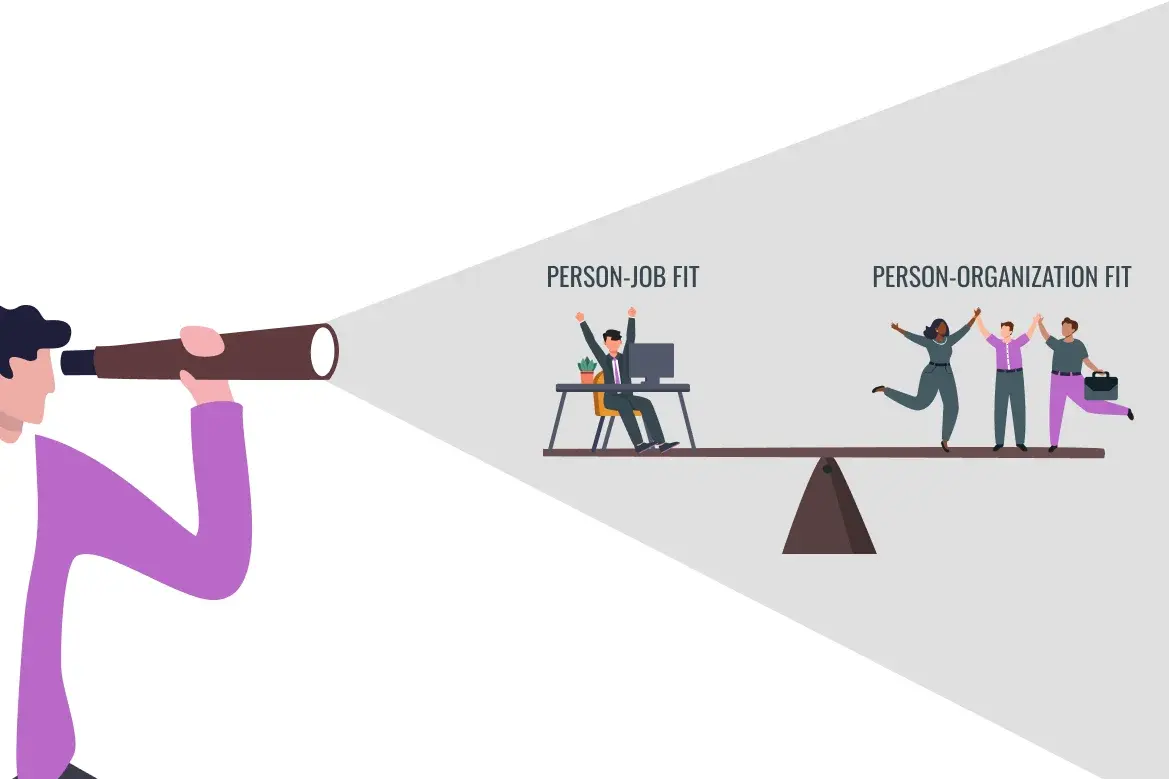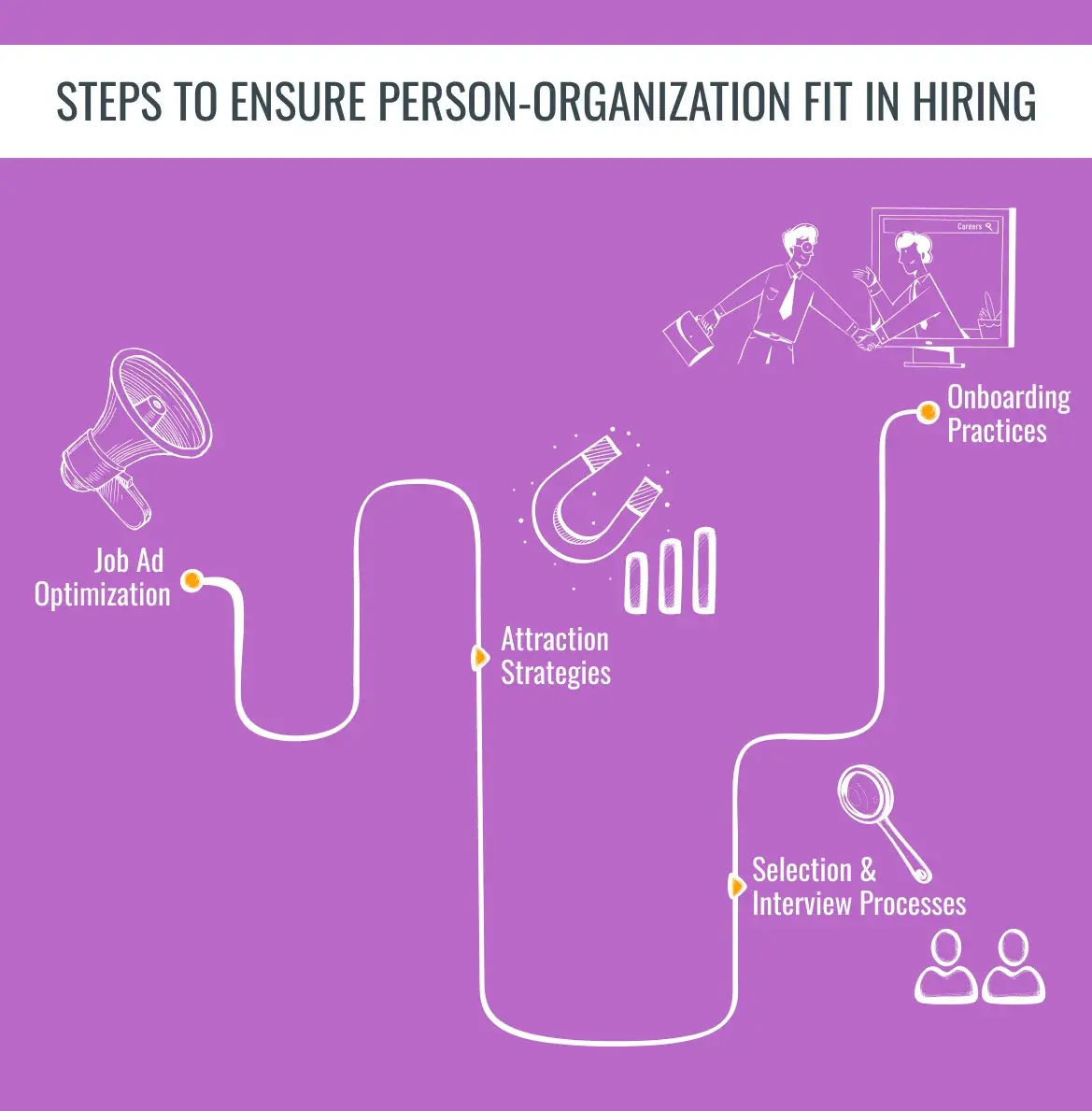Table of content
In this blog, we will dive deep into the concept of person-organization fit and provide you with practical strategies to incorporate it into your hiring process. Don’t leave your hiring success to chance. Join us on this journey as we explore the power of the concept and discover how it can transform your company’s future. Get ready to revolutionize your hiring process and ensure long-term organizational success.
Person-Organization Fit
Person-organization fit refers to the alignment between an individual and an organization in terms of values, beliefs, and work styles. It implies that when there is a strong fit, the employee can seamlessly integrate into the company’s culture and contribute to its overall success. On the other hand, a lack of this notion can lead to dissatisfaction, poor performance, and higher turnover rates.
Hiring managers should prioritize person-organization fit during the recruitment process for several reasons. Firstly, it enhances employee engagement and job satisfaction, as individuals who align with an organization’s values tend to be more motivated and invested in their work. Secondly, it improves team dynamics and collaboration by fostering a harmonious work environment. Lastly, it contributes to long-term success by reducing turnover and retaining top talent.
Person-Job Fit or Person-Organization Fit?
When it comes to hiring the right candidate, organizations often face the dilemma of whether to prioritize person-job fit or person-organization fit. Both are important factors to consider in selecting the best match for a specific role and the overall success of the organization. Let’s delve into the unique aspects and considerations of each.
Person-Job Fit
Person-job fit focuses on aligning an individual’s knowledge, skills, and abilities with the requirements of a specific job. It assesses how well a candidate’s qualifications and experiences match the technical demands and responsibilities of the role. This approach aims to find an optimal match between the candidate and the position they’ll be filling.
Person-Organization Fit
On the other hand, person-organization fit looks beyond the specific requirements of a job and assesses how well a candidate’s values, beliefs, and behaviors align with the organization’s culture, mission, and values. It explores the compatibility between the candidate’s personality traits and the organization’s work environment.
Balancing the Perspectives
While person-job fit and person-organization fit focus on different aspects, it’s crucial to find a balance between these two considerations. Hiring solely based on person-job fit may result in selecting a candidate who can perform well in their role but struggles to adapt to the organizational culture. Conversely, hiring solely based on person-organization fit may lead to hiring individuals who align with the company values but lack the necessary skills for the job.
By striking a balance, organizations can aim for a holistic approach that ensures both the candidate’s ability to perform the job and their compatibility with the organizational culture. This can lead to higher job satisfaction, increased productivity, and reduced turnover rates.
Understanding the Importance of Person-Organization Fit
Prioritizing person-organization fit in the hiring process can have a significant impact on the success of your organization. Here’s why:
Improved Productivity
When employees feel a strong connection to the organization and its values, they are more likely to be motivated and engaged in their work. This can lead to higher levels of productivity and overall job satisfaction.
Enhanced Employee Retention
When employees feel a sense of belonging and alignment with the organization, they are more likely to stay with the company long-term. This reduces turnover rates and the associated costs of hiring and training new employees.
Better Collaboration and Teamwork
When individuals share similar values and goals, they are more likely to work well together, leading to effective collaboration and stronger teamwork. This can result in increased creativity, innovation, and problem-solving abilities within teams.
Positive Organizational Culture
Hiring individuals who align with the organization’s values and culture helps to maintain and strengthen the desired culture. This fosters a positive work environment and promotes a sense of cohesion among employees.
Steps to Ensure Person-Organization Fit in Hiring
To ensure person-organization fit when hiring candidates, there are several key steps you can follow. By incorporating these strategies into your hiring process, you can increase the likelihood of finding candidates who align with your organization’s values, culture, and goals.
Job Ad Optimization
Crafting a well-defined job ad is crucial for attracting candidates who are not only qualified for the role but also a good fit for your organization. When optimizing your job ad, consider the following:
- Clearly outline your organization’s values, mission, and culture.
- Define the specific competencies and skills required for the position.
- Use language that reflects the desired organization fit.
Attraction Strategies
Attracting candidates who align with your organization’s values and goals requires proactive recruitment strategies. Consider the following approaches:
- Focus on targeted outreach and networking to connect with individuals who share similar values and interests.
- Leverage online platforms and social media channels to showcase your organization’s culture and attract candidates who resonate with it.
- Partner with educational institutions or industry organizations that align with your organization’s values to tap into relevant talent pools.
Selection & Interview Processes
During the selection process, it’s important to assess not only the candidate’s qualifications but also their compatibility with your organization. Consider the following:
- Incorporate values-based assessments or behavioral interviews that assess the candidate’s alignment with your organization’s core values.
- Incorporate scenario-based questions or simulations that allow candidates to showcase how they would handle situations aligned with your organization’s values.
- Involve key stakeholders in the selection process to evaluate a candidate’s potential fit within the organization.
- Utilize panel interviews to gain multiple perspectives on a candidate’s fit within the organization.
- Assess a candidate’s curiosity and willingness to learn by asking questions about how they would adapt to your organization’s specific needs and challenges.
Onboarding Practices
Once you have selected a candidate who demonstrates strong person-organization fit, it’s essential to facilitate a successful onboarding process. Consider the following practices:
- Provide a thorough orientation that highlights your organization’s culture, values, and mission.
- Assign a mentor or buddy to help the new employee navigate the organization and reinforce the importance of cultural alignment.
- Continuously reinforce the organization’s values and provide ongoing support and development opportunities.
By following these steps, you can ensure that your hiring process is focused on finding candidates who not only possess the necessary skills but also align with your organization’s values and culture.
Potential Problems of Person-Organization Fit
Assessing and achieving person-organization fit in the hiring process can present challenges and obstacles that organizations need to navigate. Here are some potential problems that may arise:
Limited Understanding of Organizational Culture
One of the main challenges is gaining a comprehensive understanding of the organization’s culture. Assessing whether a candidate aligns with the cultural values and norms requires a deep understanding of the company’s work environment, values, and practices. Without this understanding, it can be difficult to accurately evaluate whether a candidate will fit into the organization.
Subjective Assessment
Assessing person-organization fit is subjective, as it involves evaluating the alignment of values, goals, and attitudes. Different hiring managers may have varying interpretations of what constitutes a good fit based on their own perspectives. This subjectivity can introduce biases and inconsistencies in the evaluation process.
Lack of Objective Measures
Unlike technical skills or qualifications, person-organization fit is a more intangible aspect of the hiring process. It can be challenging to develop concrete metrics or objective measures to assess fit accurately. This lack of quantifiable criteria can make it difficult to compare candidates objectively.
Trade-Offs Between Fit and Diversity
Emphasizing person-organization fit too heavily can lead to a lack of diversity within the organization. Hiring managers may prioritize candidates who closely resemble existing employees, potentially limiting the organization’s ability to benefit from diverse perspectives and experiences.
Time and Resource Constraints
Assessing person-organization fit requires time and resources. Conducting comprehensive interviews, evaluating cultural compatibility, and soliciting feedback from multiple stakeholders can be time-consuming. Organizations with limited resources may struggle to allocate sufficient time and effort to thoroughly assess fit.
To overcome these potential problems, organizations can foster a people first culture of open communication, provide clear definitions and expectations of fit, incorporate diverse perspectives in the evaluation process, and continuously refine their assessment methods. By addressing these challenges, organizations can improve the likelihood of finding candidates who fit well within the company culture and contribute to long-term success.
Conclusion
In conclusion, prioritizing person-organization fit in the hiring process is essential for long-term success. By ensuring that candidates align with the values, culture, and goals of your organization, you not only increase the chances of hiring the right talent but also boost profits and productivity.
Throughout this article, we have explored the concept of person-organization fit, comparing it to person-job fit and highlighting its unique importance. We have discussed the steps involved in incorporating person-organization fit into your hiring practices, including job ad optimization, attraction strategies, selection processes, interviewing techniques, and onboarding practices.



